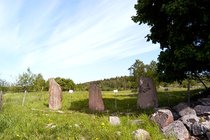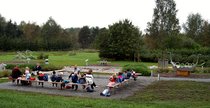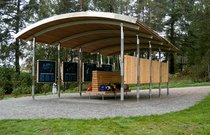Rune Kingdom – around the Vallentuna lake
The area around the Vallentuna lake is rich in rune stones, often standing where they once were raised 1,000 years ago. Nowhere else in Sweden – indeed, nowhere else in the world – are so many rune stones of such rich variety concentrated as they are in this region. A visit to the Rune Kingdom in Vallentuna and Täby will give you the chance to get to grips with the history of rune stones.
A thousand years ago, powerful chieftains such as Ulf in Skålhamra and Jarlabanke in Täby controlled the area around the Vallentuna lake. The rune stones they raised tell of building bridges, court sessions, and journeys abroad. They are also hereditary documents and property boundaries from a time of fundamental change in society. The country was in the process of uniting under one king, and Christianity was advancing. The rune stones provide direct contact for us with the people of past ages.
An outdoor exhibition opened at Jarlabanke’s Causeway just north of Täby Church in 2006 with information about the history, archaeology and sights from the Viking age around the lake at Vallentuna. A playground with the same theme has been opened next to the exhibition. The Rune Kingdom opened at the same time. Starting at Jarlabanke’s Causeway, it is possible to encircle the lake on foot, cycle, car or bus, while enjoying the natural beauty of the landscape. In addition, most places are accessible to all, and it is not necessary to plan according to set opening hours. The mediaeval churches at Täby and Vallentuna are also part of the Rune Kingdom.
The Rune Kingdom consists of nine locations around the Vallentuna lake. The gateway to the kingdom is at Jarlabanke’s Causeway, just north of Täby Church. Here, you will find an information centre and outdoor exhibition, a playground and a reconstruction of the Viking monument at Jarlabanke’s Causeway.
Starting at Jarlabanke’s Causeway, it is possible to encircle the lake on foot, cycle, car or bus. Information boards have been set up at all nine locations and mobile guides describing the history of the location and more information about runes and rune stones. Car parking is available. You can either take your own picnic basket with you, or enjoy one of the restaurants around the lake.
Collaboration
The Rune Kingdom is a collaboration between the municipalities of Täby and Vallentuna, together with the Stockholm County Museum. The rural life association at Täby and the Cultural Heritage Unit of the County Administration also support the project.
1. Jarlabanke’s Causeway
The causeway is well-known, erected by a well-to-do landowner named Jarlabanke around 1050 A.D., who had the causeway built across a 150-m stretch of otherwise impassable wetland. Jarlabanke had the rune stones erected as well. Archaeologists have made studies but the causeway’s exact appearance in Jarlabanke’s day is not known. A third of the stretch has been restored to what it is known to have looked like around 1700. In the surrounding area, you can learn more about rune stones and life around Lake Vallentuna in the 11th century. The park, which is open to the public all day year round, presents history and art in a playful way.
2. Täby Church
In the 15th century, two sections of a rune stone were mortared into a wall of the church vestibule. Carved in the 11th century, they tell of Holme, who died in Italy. On the site of today’s stone church from the 13th century, a wooden church probably once stood. The site may have been property owned by Jarlabanke. Inside the church are ceiling paintings made in the 1480s by a famous Swedish church painter, Albertus Pictor.
3. Broby
Archaeologists have studied a grave here that they believe is the burial place of a woman named Estrid. She erected many of the rune stones in the region. Three of them stand here in a field a short distance from the road. The inscriptions on the stones tell of dramatic events in the life of a local clan.
4. Fällbro
We can tell that people crossed the river at this same spot a thousand years ago because of the writing on two rock surfaces next to the road, south of the river. Further to the north is a rune stone erected in memory of Jarlabanke. North of that is a burial field that indicates that there was a farm here during the Viking Age. On the burial field, facing the road, is another rock surface with runic writing, which was not discovered until 1946.
5. Risbyle
Two rune stones present us with the Skålhamra clan, the founders of Arkil’s assize place on the other side of the lake. One of the stones was raised by a man who plundered England, Ulf of Bårresta, in honor of his friend, Ulf of Skålhamra. The cross on the stone, which is of an unusual shape, has been used as the model for the coat of arms for the municipality of Täby. The stones now stand next to what was once the edge of the water. From here, the country road led to the Skålhamra estate.
6. Gällsta
In Gällsta, there are three rune stones that mention four generations of the same clan. There is a fourth stone as well, but it has no inscription, only a cross. One of the stones has been signed by Öpir, one of the most common rune carvers of the late 11th century. On another stone, you can clearly see the repair marks that were made after it had been cut in two in the 19th century to be used as gateposts at a nearby farm.
7.Gullbron
Documents from the 17th century describe four raised stones by the Gullbron causeway. One of them still stands here, while another is not far away, by the road to Lindönäs, and the third stands two km to the north, at the Lindö estate. The fourth is missing. The writing on the stones says that heirs to Ulf of Lindö erected the stones and made the causeway. There is a fifth rune stone by the road, but it has no known connection to the other four.
8. Vallentuna Church
Here you can see several examples of rune carvings: stone-cutters who carved their names in runes when the church was being built in the late 12th century, a rune stone telling of a shipwreck mortared into the wall, and one of Jarlabanke’s own rune stones. This last stone must have cracked at some point and new carving was made on the back. On the stone, Jarlabanke tells us that he built an assize place and that he alone made all the decisions in the region. Half of a rune stone stands by the eastern wall of the cemetery.
9. Arkil’s Assize Place
On two rune stones, the sons of Ulf from Skålhamra tell how they raised the stones, made a large staff, and built an assize place in memory of their father. On the ground, an intriguing four-sided stone formation can be seen. Exactly what people did during assize assemblies is not known. Visitors came by water and docked their boats nearby.
Closest public transport is the SL bus stops at Täby kyrkby, Bällsta, and Vallentuna stations.




